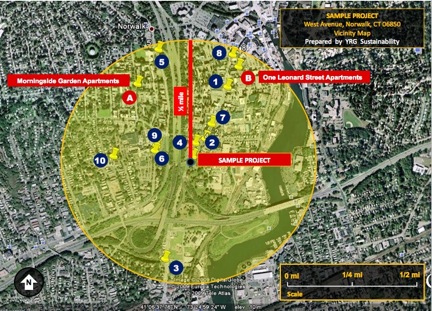This credit addresses two basic issues: density of the surrounding neighborhood and occupant access to everyday services. It encourages use of existing infrastructure and tries to reduce environmental impacts of transportation. It’s easier for projects located in a densely built area or with a host of community services nearby.
This credit is not likely to drive the project location decision, but it does reward projects for locating in developed areas and for choosing infill instead of greenfield sites (you can’t earn the credit on a site that is not previously developed). In determining how easily your project can comply, site selection is one key factor, but so is the availability of property and building data.
Two compliance options
There are two compliance options for this credit. Unless you are in a dense urban neighborhood where either option is possible, your choice will probably be determined by the specifics of your project.
- Option 1: Development Density requires the density of the community to be 60,000 square feet of floor area per acre or more. This is a typical density for a two-story downtown development.
- Option 2: Community Connectivity requires connections to neighborhood services as well as to housing with at least 10 units per acre. This option could apply to a variety of settings, from urban areas to rural small towns with a density of services.
Documentation is key
Project teams should assess early in the planning stage which path is most suitable based on project location and the availability of density data. The owner, architect or civil engineer often take on the role of documenting this credit—either researching community services in the project’s vicinity, or documenting the density of the project and surrounding area.
Option 2: Community Connectivity is generally easier to document than Option 1.
Projects can earn an Exemplary Performance point through IDc1 if they meet Option 1’s requirements and are themselves twice as dense as the surrounding area, or can show that the surrounding area has double the required Option 1 density over twice the area.
Eight of the ten services for Option 2 have to be existing and in operation at the time of the project opening. Two services can be anticipated within a year of opening. One service can be within the project itself.
Differences between NC v2.2 and NC 2009
The credit requirements for v2.2 and v2009 are exactly the same, However, the specifics of what can qualify as a basic service are further defined and outlined in v2009.
For v2.2, basic services that are in construction by project completion can contribute to the credit requirements. For v2009, these basic services must be in operation. Additionally, for mixed-use projects, under v2.2 no basic services that are part of your project can contribute to the credit requirements. In v2009, one service can be within the project itself.
